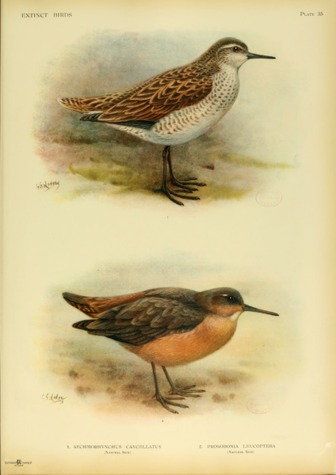Tuamotu Sandpiper
The Tuamotu Sandpiper, Prosobonia cancellata, is an endangered member of the large wader family Scolopacidae, that is endemic to the Tuamotu Islands in French Polynesia. It is sometimes placed in the monotypic genus Aechmorhynchus. A native name, apparently in the Tuamotuan language, is kivi-kivi.

The Tuamotu Sandpiper is classified as Endangered (EN), considered to be facing a very high risk of extinction in the wild.
The Tuamotu Sandpiper or Titi is the only surviving member of the Tribe Prosoboniini and is confined to eastern Polynesia. Formerly distributed throughout the Tuamotu Archipelago, it has been decimated by mammalian predators which now occur on nearly all atolls of the archipelago. Isolated sandpiper populations are currently known from only four uninhabited atolls in the Tuamotu. Only two of these are currently free of mammalian predators, such as cats and rats, and the risks of rat invasion on them are high. More
The Tuamotu Sandpiper, Prosobonia cancellata, is an endangered member of the large wader family Scolopacidae, that is endemic to the Tuamotu Islands in French Polynesia. It is sometimes placed in the monotypic genus Aechmorhynchus. A native name, apparently in the Tuamotuan language, is kivi-kivi. More
* Tuamotu Sandpiper, Aechmorhynchus parvirostris * Upland Sandpiper, Bartramia longicauda * Western Sandpiper, Calidris mauri * White-rumped Sandpiper, Calidris fuscicollis * Wood Sandpiper, Tringa glareola Translations bird of the family Scolopacidae * Chechen: цIога лесто хин олхазар * Czech: jespák cs(cs) m. * Scottish Gaelic: luatharan gd(gd) m. More
The Tuamotu sandpiper (Prosobonia cancellata) is a small wader with a very short, sharp black bill. It is about 17 cm tall. It is variably mottled and streaked with dull brown, with a bold white superciliary stripe. Its voice is a high squeaking note. It is found on beaches, shores and in scrub, preferring open areas along atoll shorelines, where it feeds on insects among coral rubble and leaf-litter. It is non-migratory but may visit islands where it does not nest. More
5 cm long Tuamotu Sandpiper is a small, short-winged, mottled brown bird with more or less barred underparts. Its short sharp beak is more like that of an insectivorous passerine than a wader. There are two color phases which intergrade. Pale birds are medium brown above and white below, with light barring or spotting on the breast and whitish streaking on the head. The bold supercilium and the chin are also white. More
The Tuamotu sandpiper is a small, short-winged wader with a variably mottled brown and buff plumage, a bold creamy-white stripe above the eye and a very short, sharp black bill. Underparts are generally paler than upperparts, and may be spotted or ... More
The Tuamotu sandpiper has disappeared from much of its former range and is undergoing a continuing decline due to habitat loss and the effects of introduced species. The threats to the survival of this bird are mounting as its island environment becomes increasingly colonised, encroached upon and disturbed by humans, who destroy habitat for settlements and coconut plantations. More
photo of the Tuamotu Sandpiper BirdCancellata - of the Cancellata species - and lists its size, weight, and number in existence at the time of the advertisement. Atolls in the Tuamotu Archipelago in the Pacific Ocean are stated as the animal's habitat range. Roland Seitre is the photographer. Price: $10. More
Stamps showing Tuamotu Sandpiper Aechmorhynchus parvirostris Tuamotu Sandpiper Aechmorhynchus parvirostris 64.035 Tuamotu Sandpiper IOC v2.4: 1619 Links will open countrypage in new window - French Polynesia 21.06. More
Results for: tuamotu sandpiperTranslations 1 - 28 of 28 English English Finnish Finnish tuamotu sandpiper tuamotunsirri, Aechmorhynchus parvirostris tuamotu kingfisher tuamotunkalastaja, Todiramphus gambieri sandpiper vikla, sirri, viklo least sandpiper amerikansirri, Calidris minutilla semipalmated sandpiper kanadansirri, Calidris pusilla solitary sandpiper amerikanmetsäviklo, Tringa solitaria spotted sandpiper More
NOTEWORTHY FAUNA The Tuamotu Sandpiper (Prosobonia cancellatus) was found commonly on both atolls in 1969, and was presumed to be breeding. The threatened Polynesian Ground Dove (Gallicolumba erythroptera erythroptera) was recorded as uncommon on Maturei Vavao in 1968 (Lacan and Mougin, 1974). This is the only site at which the species has been recorded in recent decades (Hay, 1985). (The other subspecies, G. e. pectoralis, which is known only from the Society Islands, may now be extinct). NOTEWORTHY FLORA No information. More
Tuamotu sandpiper (Prosobonia cancellata), which is now restricted to uninhabited, rat-free islands. The Tuamotus are also important wintering habitat for the Bristle-thighed curlew (Numenius tahitensis)(Stattersfield et al. 1998). Unlike much of the Pacific, this ecoregion still possesses a number of fairly pristine islands, although for differing reasons. Henderson Island provides a glimpse into what the forests of atoll and limestone islands would have once looked like throughout the Pacific. More
Family : Scolopacidae
Genus : Prosobonia
Species : cancellata
Authority : (Gmelin, 1789)

